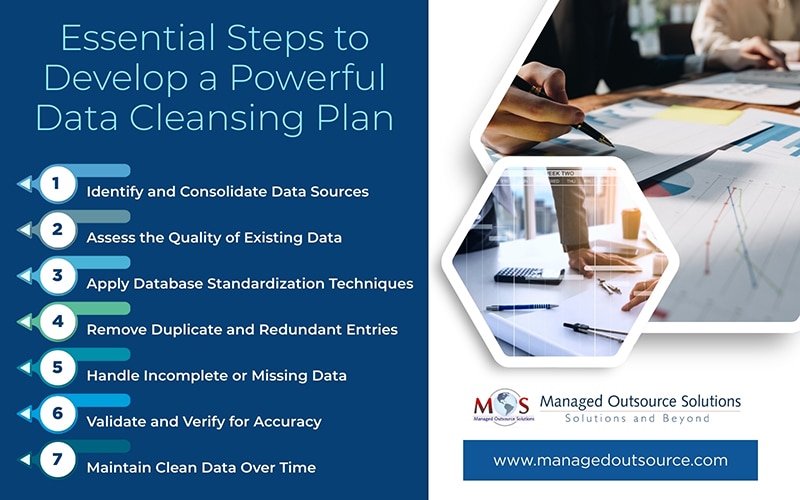In today’s hyper-digital age, businesses rely on data to drive nearly every decision—from marketing and sales to product development and customer support. However, without clean, reliable, and up-to-date data, even the most sophisticated analytics or AI tools can produce misleading insights. This is where data cleansing services become essential. By implementing a strong data cleansing strategy, businesses can remove inaccuracies, duplicates, and inconsistencies to unlock more accurate analysis and improved performance across departments.
Why Clean Data Matters More Than Ever
Clean data is the foundation of accurate decision-making. Yet, many companies underestimate how costly bad data can be. According to a study by IBM, poor data quality costs U.S. businesses over $3.1 trillion annually. From wasted marketing budgets to flawed reports and customer dissatisfaction, the impact of dirty data extends across the entire organization.
Without a proper data cleansing process, teams may act on incorrect assumptions, misinterpret customer behavior, or even lose valuable leads. Errors in data also cause inefficiencies that delay projects, confuse staff, and damage client trust. Inaccurate, duplicate, or outdated data can lead to flawed insights, misguided strategies, and missed opportunities. Clean data ensures that decision-makers are working with reliable information, which is crucial for everything from forecasting trends to targeting customers effectively. By eliminating errors and standardizing datasets, organizations can trust the reports, KPIs, and analytics they rely on daily. Ultimately, data cleansing enables businesses to respond swiftly to market demands, optimize internal processes, and make strategic choices that are grounded in truth rather than assumptions.
What Is Data Cleansing?
Also known as data scrubbing, data cleansing involves identifying and fixing errors such as duplicates, formatting inconsistencies, outdated records, and incomplete fields. It ensures that high-quality business data is consistently available for use.
A robust data cleansing strategy doesn’t just fix errors—it prevents them from occurring again. It establishes policies, tools, and workflows that ensure incoming data is accurate and aligned with business standards.
Step-by-Step Guide to Building a Strong Data Cleansing Strategy
- Identify and Consolidate Data Sources
Start by mapping out where your data is coming from. Whether it’s CRM systems, spreadsheets, marketing tools, or customer service platforms, consolidate these into a centralized system. Fragmented data sources are breeding grounds for errors, redundancies, and misalignment.
- Assess the Quality of Existing Data
- Duplicates
- Missing values
- Inconsistent formats
- Outdated records
Perform a thorough audit to determine the state of your current datasets. Look for:
This step is essential for understanding where your biggest data issues lie and what fixes will bring the most business value.
- Apply Database Standardization Techniques
Standardizing your database ensures consistency in formats, naming conventions, units, and data types. For instance, ensuring all date fields follow the same format (MM/DD/YYYY) or that customer names use proper capitalization helps reduce confusion and improves the professionalism of outbound communications.
- Remove Duplicate and Redundant Entries
Duplicates not only waste storage space but also lead to flawed reporting and poor customer experiences. Removing redundant records is crucial for data accuracy and consistency. With a reliable deduplication process in place, businesses can avoid sending multiple communications to the same contact or generating conflicting reports.
- Handle Incomplete or Missing Data
Missing values can lead to broken dashboards, inaccurate analytics, and poor customer targeting. Instead of simply deleting incomplete records, consider strategies such as cross-referencing other datasets or using intelligent algorithms to fill in missing information. This ensures you retain valuable records while improving their reliability.
- Validate and Verify for Accuracy
- Cross-checking entries against trusted sources
- Running real-time error detection scripts
- Testing data queries for accuracy and completeness
- Ensuring accuracy at this stage reduces the risk of flawed decisions.
After cleaning your data, it’s critical to verify its accuracy. Use validation techniques like:
- Automate with AI-powered Tools
Manual cleansing is not scalable for growing enterprises. Automating the process using AI tools significantly boosts transcription workflow efficiency and helps maintain data integrity. AI can spot patterns, predict missing data, and validate information much faster than human teams, freeing up time and resources.
- Maintain Clean Data Over Time
- Scheduled data audits
- Real-time error monitoring
- Employee training
- Data governance policies
- Improving marketing ROI through clean customer data
Marketing campaigns are only as good as the data behind them. Clean contact records, accurate segmentation, and trustworthy engagement data ensure that your messages reach the right audience, boosting conversions and lowering costs. - How to improve business efficiency with data cleansing
When data is accurate and accessible, teams spend less time fixing errors and more time executing strategies. Departments become more agile, reporting becomes more reliable, and decision-making becomes faster and more effective.
Data hygiene isn’t a one-and-done task. Companies must adopt ongoing practices like:
These practices form the foundation of strong enterprise data hygiene, ensuring your data stays clean and useful over time. Following effective data cleansing tips and a solid data cleansing strategy helps businesses maintain data accuracy and streamline operations. This powerful combination minimizes errors, supports informed decision-making, and ultimately boosts overall efficiency and profitability.
Common Data Cleansing Mistakes and How to Avoid Them
How Clean Data Transforms Business Operations
A strong data cleansing strategy does more than tidy up spreadsheets. It has a tangible impact on core business metrics:
Why Outsourcing Data Cleansing Makes Sense
Many businesses lack the in-house resources or tools to carry out effective cleansing at scale. By outsourcing to professional data cleansing services, companies gain access to specialized tools and expertise that ensure cleaner data faster. These services help businesses avoid costly errors, comply with regulations, and scale their operations with confidence.
In the competitive world of modern business, clean data isn’t optional, it’s a necessity. Whether you’re a small business or a global enterprise, a strong data cleansing strategy lays the groundwork for accurate analytics, better decision-making, and stronger customer relationships. With the support of data cleansing services, businesses can safeguard data integrity, eliminate inefficiencies, and drive consistent growth.





